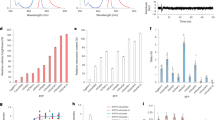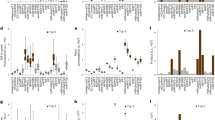Abstract
The recent emergence of an autofluorescent protein, the green fluorescent protein (GFP), has opened the door for the convenient use of intact living cells and organisms as experimental systems in fields ranging from cell biology to biomedicine. We present an overview of some of the major applications of GFP, namely its use in protein tagging and in monitoring gene expression as well as its potential in a variety of biological screens.
This is a preview of subscription content, access via your institution
Access options
Subscribe to this journal
Receive 12 print issues and online access
$209.00 per year
only $17.42 per issue
Buy this article
- Purchase on Springer Link
- Instant access to full article PDF
Prices may be subject to local taxes which are calculated during checkout
Similar content being viewed by others
References
Prasher, D., Eckenrode, V., Ward, W., Prendergast, R. and Cormier, M. 1992. Primary structure of the Aequorea victoriagreen-fluorescent protein. Gene 111: 229–233.
Prasher, D. 1995. Using GFP to see the light. Trends Genet 11: 320–323.
Chalfie, M., Tu, Y., Euskirchen, G., Ward, W. and Prasher, D. 1994. Green fluorescent protein as a marker for gene expression. Science 263: 802–805.
Ormö, M., Cubitt, A., Kallio, K., Gross, L., Tsien, R. and Remington, S. 1996. Crystal structure of the Aeguorea victoria green fluorescent protein. Science 273: 1392–1395.
Yang, F., Moss, L.G., and Phillips, G.N. 1996. The molecular structure of green fluorescent protein. Nature Biotechnology 14: 1246–1251.
Wachter, R.M., King, B.A., Heim, R., Kallio, K., Tsien, R.Y., Boxer, S.G. et al. 1997. Crystal structure and photodynamic behavior of the blue emission variant Y66H/Y145F of green fluorescent protein. Biochemistry 36: 9759–9765.
Heim, R., Prasher, D. and Tsien, R. 1994. Wavelength mutations and posttranslational autoxidation of green fluorescent protein. Proc. Natl. Acad. Sci. USA 91: 12501–12504.
Heim, R. and Tsien, R. 1996. Engineering green fluorescent protein for improved brightness, longer wavelengths and fluorescence resonance energy transfer. Curr. Biol. 6: 178–182.
Cormack, B., Valdivia, R. and Falkow, S. 1996. FACS-optimized mutants of the green fluorescent protein (GFP). Gene 173: 33–38.
Palm, G.J., Zdanov, A., Gaitanaris, G.A., Stauber, R., Pavlakis, G.N. and Wlodawer, A. 1997. The structural basis for spectral variations in green fluorescent protein. Nature Struct. Biol. 4: 361–365.
Siemering, K., Golbik, R., Sever, R. and Haseloff, J. 1996. Mutations that suppress the thermosensitivity of green fluorescent protein. Curr. Biol. 6: 1653–1663.
Zolotukhin, S., Potter, M., Hauswirth, W., Guy, J. and Muzyczka, N. 1996. A humanized green fluorescent protein cDNA adapted for high-level expression in mammalian cells.J. Virol. 70: 4646–4654.
Zemicka-Goetz, M., Pines, J., McLean Hunter, S., Dixon, J., Siemering, K. Haseloff, J. et al. 1997. Following cell fate in the living mouse embryo.Development 124: 1133–1137.
Zernicka-Goetz, M., Pines, J., Ryan, K., Siemenng, K., Haseloff, J., Evans, M. et al. 1996. An indelible lineage marker for Xenopus using a mutated green fluorescent protein. Development 122: 3719–3724.
Kahana, J. and Silver, P. 1996. Use of the A. victoria green fluorescent protein to study protein dynamics in vivo. Cur. Prof. Mol. Biol. 9.7.22–9.7.28.
Cormack, B., Bertram, G., Egerton, M., Gow, N., Falkow, S. and Brown, A. 1997. Yeast-enhanced green fluorescent protein (yEGFP)a reporter of gene expression in Candida albicans. Microbiology 143 (Pt 2):303–311.
Chiu, W.t Niwa, Y., Zeng, W., Hirano, T, Kobayashi, H. and Sheen, J. 1996. Engineered GFP as a vital reporter in plants. Curr. Biol. 6: 325–330.
Haseloff, J., Siemenng, K., Prasher, D. and Hodge, S. 1997. Removal of a cryptic intron and subcellular localization of green fluorescent protein are required to mark transgenic Arabidopsis plants brightly. Proc. Natl. Acad. Sci. USA 94: 2122–2127.
Wang, S. and Hazelrigg, T. 1994. Implications for bed mRNA localization from spatial distribution of exu protein in Drosophila oogenesis. Nature 369: 400–403.
Cole, N., Smith, C., Sciaky, N., Teresaki, M., Edidin, M. and Lippmcott-Schwartz, J. 1996. Diffusional mobility of Golgi proteins in membranes of living cells. Science 273: 797–801.
Shelby, R., Hahn, K., and Sullivan, K. 1996. Dynamic elastic behavior of alpha-satellite DNA domains visualized in situ in living human cells. J. Cell Biol. 135: 545–557.
Kahana, J., Schnapp, B., and Silver, P. 1995.Kinetics of spindle pole body separation in budding yeast. Proc. Natl. Acad. Sci. USA 92: 9707–9711.
Straight, A.F., Marshall, W.F., Sedat, J.W. and Murray, A.W. 1997. Mitosis in living budding yeast: anaphase A but no metaphase plate. Science 277: 574–578.
Olson, K., Mclntosh, J. and Olmsted, J. 1995. Analysis of MAP 4 function in living cells using green fluorescent protein (GFP) chimeras. J. Cell Biol. 130: 639–650.
Lee, M.S., Henry, M. and Silver, P.A. 1996. A protein that shuttles between the nucleus and the cytoplasm is an important mediator of RNA export. Genes and Dev. 10: 1233–1246.
Wacker, I., Kaether, C., Kromer, A., Migala. A., Aimers, W. and Gerdes, H.H. 1997. Microtubule-dependent transport of secretory vesicles visualized in real time with a GFP-tagged secretory protein.J. Cell Set. 110: 1453–1463.
Kaether, C. and Gerdes, H. 1995. Visualization of protein transport along the secretory pathway using green fluorescent protein. FEBS Letters 369: 267–271.
Misteli, T., Caceres, J.F. and Spector, D.L. 1997. The dynamics of a pre-mRNA splicing factor in living cells. Nature 387: 523–527.
Robinett, C., Straight, A., Li, G. Willhelm, C., Sudlow, G., Murray, A., et al. 1996. In vivo localization of DNA sequences and visualization of large-scale chromatin organization using lac operator/repressor recognition. J. Cell Biol. 135: 1685–1700.
Straight, A., Belrnont, A., Robinett, C., and Murray, A. 1996. GFP tagging of budding yeast chromosomes reveals that protein-protein interactions can mediate sister chromatid cohesion. Curr. Biol. 6: 1599–1608.
Webb, C., Teleman, A., Gordon, S., Straight, A., Belmont, A., Lm, D. et al. 1997. Bipolar localization of the replication origin regions of chromosomes in vegetative and sporulatmg cells of 8. subtilis. Cell 88: 667–674.
Subramanian, S. and Srienc, F. 1996. Quantitative analysis of transient gene expression in mammalian cells using the green fluorescent protein. J. Biotechnol. 49: 137–151.
Peel, A.L. Zolotukhm, S., Schrimsher, G.W., Muzyczka, N. and Reier, R.J. 1997. Efficient transduction of green fluorescent protein in spinal cord neurons using adeno-associated virus vectors containing cell type-specific promoters. Gene Ther. 4: 16–24.
Phillips, M.I., Mohuczy-Dommiak, D., Coffey, M., Galh, S.M., Kimura, B., Wu, P. et al. 1997. Prolonged reduction of high blood pressure with an in vivo, non-pathogenic, adeno-associated viral vector delivery of AT1-R mRNA antisense. Hypertension 29: 374–380.
Wilson, L.E., Wilkinson, N., Marlow, S.A., Possee, R.D. and King, L.A 1997. Identification of recombmant baculoviruses using green fluorescent protein as a selectable marker. Biotechniques 22: 674–676.
Takada, T., lida, K., Awaji, T., Itoh, K., Takahashi, R., Shibui, A., et al. 1997. Selective production of transgenic mice using green fluorescent protein. Nature Biotechnology 15: 458–461.
Okabe, M., Ikawa, M., Kominami, K., Nakanishi, T. and Nishimune, Y. 1997. Green mice as a source of ubiquitous green cells. FEBS Letters 407: 313–319.
Chishima, T., Miyagi, Y. Wang, X., Yamaoka, H., Shirnada, H., Moossa, A.R. et al. 1997. Cancer invasion and micrornetastasis visualized in live tissue by green fluorescent protein expression. Cancer Research 57: 2042–2047.
Sawin, K. and Nurse, P. 1996. Identification of fission yeast nuclear markers using random polypeptide fusions with green fluorescent protein. Proc. Natl. Acad. Sci. USA 93: 15146–15151.
Dell'Arciprete, R., Stella, M., Fornaro, M., Ciccocioppo, R., Capri, M., Naglien, A., et al. 1996. High-efficiency expression gene cloning by flow cytometry. J. Histochem. Cyiochem. 44: 629–640.
Dorsky, D., Wells, M., and Harrmgton, R. 1996. Detection of HIV-1 infection with a green fluorescent protein reporter system. J. Acquir. Immune Defic. Syndr. Hum. Retrovirol. 13: 308–313.
Gervaix, A., West, D., Leoni L.M., Richman, D.D., Wong-Staal, and Corbeil, J. 1997. A new reporter cell line to monitor HIV infection and drug susceptibility in vitro. Proc. Natl. Acad. Sci. USA 94: 4653–4658.
Htun, H., Barsony, J., Renyi, I., Gould, D., and Hager, G 1996. Visualization of glu-cocorticoid receptor translocation and intranuclear organization in living cells with a green fluorescent protein chimera. Proc. Natl. Acad. Sci. USA 93: 4845–4850.
Romoser, V.A., Hmkle, P.M. and Persechmi, A. 1997. Detection in living cells of Ca2+-dependent changes in the fluorescence emission of an indicator composed of two green fluorescent protein variants linked by a calmodulin-binding sequence. J. Biol. Chem. 272: 13270–13274.
Connolly, J.B., Roberts, I.J., Armstrong, J.D., Kaiser, K., Forte, M., Tully, T., et al. 1996. Associative learning disrupted by impaired Gs signaling in Drosophila mushroom bodies. Science 274: 2104–2107.
Author information
Authors and Affiliations
Rights and permissions
About this article
Cite this article
Misteli, T., Spector, D. Applications of the green fluorescent protein in cell biology and biotechnology. Nat Biotechnol 15, 961–964 (1997). https://doi.org/10.1038/nbt1097-961
Received:
Accepted:
Issue Date:
DOI: https://doi.org/10.1038/nbt1097-961
This article is cited by
-
Simulation-guided engineering of split GFPs with efficient β-strand photodissociation
Nature Communications (2023)
-
GFP fluorescence tagging alters dynamin-related protein 1 oligomerization dynamics and creates disassembly-refractory puncta to mediate mitochondrial fission
Scientific Reports (2020)
-
GFP fluorescence peak fraction analysis based nanothermometer for the assessment of exothermal mitochondria activity in live cells
Scientific Reports (2019)
-
Efficient Generation of Transgenic Buffalos (Bubalus bubalis) by Nuclear Transfer of Fetal Fibroblasts Expressing Enhanced Green Fluorescent Protein
Scientific Reports (2018)
-
The use of stable and unstable green fluorescent proteins for studies in two bacterial models: Agrobacterium tumefaciens and Xanthomonas campestris pv. campestris
Archives of Microbiology (2017)



